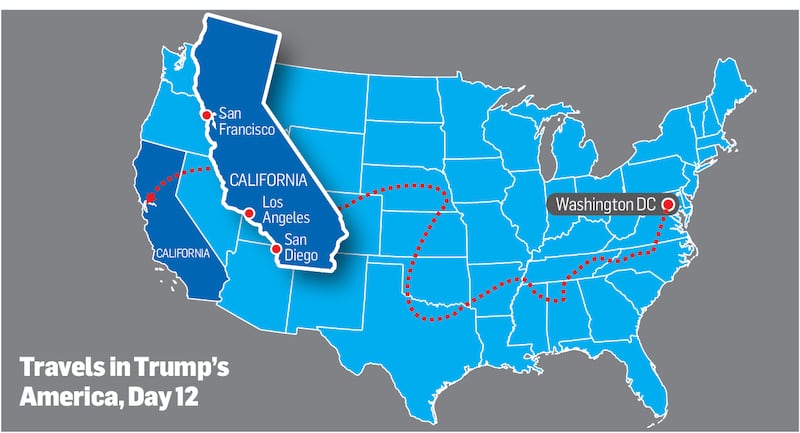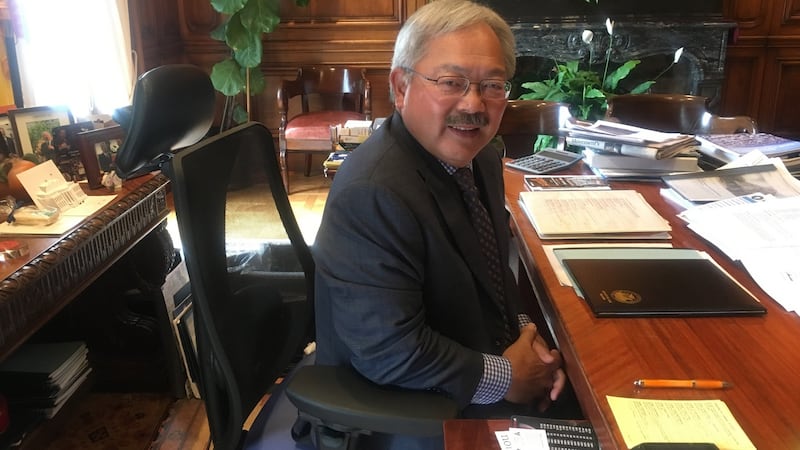As the train crosses the Sierra Nevada mountain range in California and chugs into Emeryville just outside San Francisco, I reach the west coast of America – the final stop on my two-week trip across the United States.
San Francisco, with its welcoming Golden Gate Bridge and laid-back vibe, is the epitome of west coast liberalism.

Unsurprisingly, the state of California, which has a coveted 55 electoral college votes, backed Hillary Clinton in last year's presidential election, though Donald Trump polled well in certain rural areas, as well as upmarket districts in the southern part of the state such as Orange County.
This, after all, is the homeplace of two Republican presidents – Richard Nixon, and adopted Californian Ronald Reagan, whose sunny west-coast demeanour won over a nation with his promise of low taxes and trust in the free market. George HW Bush's 1988 victory was the last time California backed a Republican president – changes in the Democratic profile of the state due to immigration have ensured that the state has since remained firmly in Democratic territory.
Summer of Love
Today San Francisco is its usual bustling self, packed with tourists and tech types. But this summer is particularly busy – I arrive in the midst of the 50th anniversary commemoration of the Summer of Love. The city is holding a series of events to mark the events of the summer of 1967, when tens of thousands of people descended on Golden Gate Park and the Haight-Ashbury district of the city to proclaim peace, love and flower power, spawning a thousand songs and solidifying San Francisco’s reputation as a centre of tolerance and liberalism.
Fifty years on, how is San Francisco living up to its liberal credentials?
Pretty well, it seems. As I walk around the Haight-Ashbury district, the colourful buildings and political slogans are still there, while small groups of hippies are gathered near the entrance of Golden Gate Park, where dozens of free concerts are taking place this summer to commemorate the Summer of Love.
I stop for lunch at a tiny Cuban-Costa Rican restaurant where I chat to Jam, Lillian and Danny, three San Francisco residents. Unsurprisingly, they voted for Hillary Clinton. Jam explains that he left Cuba in 1990. He sees similarities between Trump and Castro. "It was the same with Hitler, with Castro. These people have one or two ideas that resonate with people – too much uncontrolled immigration, low wages – and then they draw them in when in fact their ideas become much more extreme. They make promises that they can't keep."
Although he and his family, as immigrants, feel welcome in San Francisco, he believes that an anti-immigration feeling is growing in American society, even in California. "It is ironic. People here eat Mexican food – in fact Mexican people were in California before most white Europeans. You don't hear Trump saying he will build a wall with Canada, just with Mexico. It's purely a racial issue."
Anti-Trump feeling
The anti-Trump feeling in San Francisco is also finding expression at a more official level. Downtown I sit down with the city's mayor, Ed Lee, in San Francisco's magnificent city hall. San Francisco is one of the many "sanctuary cities" – cities that limit co-operation between their law enforcement personnel and federal immigration authorities.
Earlier this week the city launched a lawsuit against the US justice department over threats to remove federal funding from sanctuary cities, while it also sued the government over Trump’s executive order on immigration earlier this year.

“I have the privilege of representing a very diverse city,” Lee tells me. “We still have a lot of the ethos that existed 50 years ago and drew people here – San Francisco was open, it was inclusive, it listened to different opinions and we became better citizens as a result of that effort to be diverse. Trump wants to take us back to a different time – a time when people were not accepting of difference, of different views.”
Lee, an Asian-American and former civil rights attorney, has been at the forefront of the challenge to Trump’s attempts to clamp down on immigration and immigrant communities across the United States. Next month he is due to visit Cork, one of San Francisco’s sister cities across the world.
“What we have tried to make clear to the administration is that what we are doing is in compliance with the law – it keeps our cities safe. When you have people who may be undocumented but they’re taking their kids to school, acting as witnesses in investigations, living regular lives, what you have is a fully-fledged engaged citizenry. When you start trying to turn local police officers into immigration officers, which we believe the administration is doing, all of a sudden people start living in fear. They stop engaging in society.”
He says San Francisco’s proud history as a sanctuary city “does not mean we harbour criminals”. “We will identity criminals and prosecute them as much as any other jurisdiction but the majority of our immigrants are not criminals. This is a false tag that has been made by the federal administration.”
As I wander around the streets near San Francisco Bay, the reverberations of the latest Trump scandal are being felt. Like many communities across the country, San Francisco has held vigils and rallies to protest against last weekend’s violence in Charlottesville, Virginia.
I reflect on my two-week journey through America and this divided country.
Driving from Tennessee, through Alabama, to Mississippi and Texas, and then moving farther north to Nebraska, Utah and California, I have found that America is beset by division and polarisation. This is borne out by statistics.
A survey by Pew Research last year found that 55 per cent of Democrats say the Republican Party makes them "afraid", while 49 per cent of Republicans feel similarly about Democrats. Among those who vote regularly, the percentage rises to 70 per cent and 62 per cent respectively.
That intense partisanship is underscored by a divided media – the absence of a national broadcaster has facilitated the emergence of a highly partisan media climate, with consumers turning to the cable news offerings that reflect their own political views. Fox News – which regularly runs clips of “liberal media’s” reportage of the day’s developments and systematically presents opinion in place of fact – gives a daily platform to Trump and a justification for his policies. Backing Trump appears to have paid off for now – it retains the number one ratings spot.
But more liberal outlets, while playing a crucial role in holding Trump to account, are also guilty at times of promoting a biased agenda. Churning out coverage of the Trump administration with minimal input from conservative voices or perspectives, it is also contributing to the climate of partisanship. The Trump factor has been good for the bottom line of liberal as well as conservative outlets – CNN posted profits of $1 billion last year.
No homogenous voter
Talking to Trump supporters around the country, it becomes clear that there is no homogenous Trump voter, despite the tendency to caricature his typical supporter as a disenfranchised, uneducated, white, working-class man.
While the so-called rust belt states, populated with white working-class voters who feel left behind by globalisation, played a crucial role in pushing the swing states in favour of Trump, the Trump phenomenon is not just confined to the working classes. Sixty-three million people voted for Trump, many of them middle class, educated men and women, from southern states such as Alabama and Arkansas to the great rural states of Nebraska and Utah in the northwest.
But there are some unifying factors among the president’s supporters.
Throughout the country, Trump’s business credentials were cited as one of his main attractions as a candidate. The sense that he could “get things done” surfaced again and again, as well as a belief that his wealth meant that he was not beholden to any vested interest – a sorry reflection perhaps on the role that money continues to play in American presidential elections.
Secondly, while almost all Trump supporters said they did not agree with his tweets and found some of his language objectionable, they liked that he “says it as it is”, and believe that he would not be afraid to do what he thinks is right if needed.
Thirdly, support for Trump emerged not so much from a belief that he was the right candidate, but that Hillary Clinton needed to be stopped at all costs. Trump may have been a problematic candidate, but Clinton was worse, according to many Trump supporters.
In the end, on my journey, partisanship stood out above all. Republicans were always going to vote for the Republican candidate; Democrats for the Democrat. It is part of the reason why Trump, despite having record low ratings, continues to command support among most of those who voted for him, though not among those who didn’t.
Trump phenomenon
The blame for the Trump phenomenon lies squarely at both parties’ doors – Democrats for failing to select the right candidate, for all Clinton’s competence and experience, and Republicans for allowing a candidate like Trump to get this far.
The United States seems more disunited than in any recent period of its history. What is most concerning about last weekend’s violence in Charlottesville is that it tapped into the dynamics that underpinned the civil war more than a century and a half ago – dynamics centred squarely on race.
For those who contend that Trump’s victory was in part a reaction to the country electing a black president, last Saturday’s violence in Virginia – a state that was the heartland of the South in the civil war – was proof that it has enabled a latent racism running through American life to find a legitimate voice in modern political discourse.
As I finish my journey in California I’m reminded of the words of a Democratic voter – a high-school teacher from Los Angeles – who I met just before leaving DC.
I told him I was embarking on a trip across the United States to find the “real America”. Although I said the words with a smile, he responded with cautionary words. “We are the real America. I am the real America. Millions of people may have voted for Donald Trump, but more people voted for Hillary Clinton. Don’t ever forget that.”
Series concluded.











